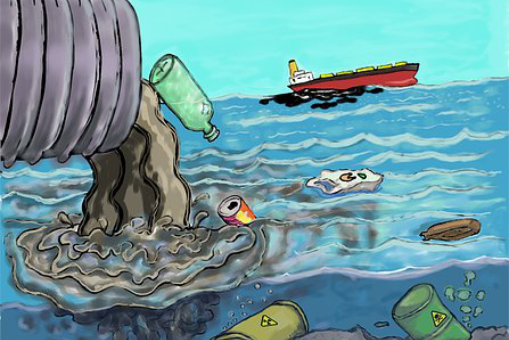LittleDot team of experts educating you for child's better heath
All articlesInfant massage techniques and benefits for infant and parents

The massage has a long tradition. In India, birth is followed by an oil massage, then exercises and finally a warm bath for the mother and newborn infant. Such customs have been known since antiquity, and are still performed in the same way today. The newborn infant initially communicates through the skin and touch. This is how the infant speaks to us. One of the benefits of massages is that they help us understand the infant’s non-verbal language.
Massaging helps accelerate the process of brain maturation. Moreover, studies have shown that prematurely born children who received massages had a 47% larger weight gain, compared to prematurely born children who did not receive massages.
Further benefits of infant massage include its positive influence on the circulation of the body, the digestive tract (especially when massage is used to alleviate infant cramps) and the sensory system (sight, sound).
Positions assumed to perform a massage allow eye contact between the infant and the person performing the massage (usually the mother or father). In this way, they can achieve better connection and closeness with their child. The child becomes relaxed and feels loved.
Parents also benefit from the massage as they gain confidence in themselves and the way in which they behave with their child (especially if this is their first-born). They recognise the infant’s signals and needs, which is crucial for establishing successful communication between them.
Each mother (parent) instinctively caresses (massages) her child. However, the challenges of modern life prevent her from spending the entire day massaging her infant. The massage exercises described here are therefore specifically designed to be as efficient and useful as possible. Massaging can begin immediately after birth, but usually commences after the mother and infant have been discharged from hospital.
Initially, the massage should last for only a few minutes. Over time, as parents become more confident and (even more importantly) when the infant begins to anticipate what is about to happen, the massage session can last for 20 to 30 minutes. The recommended frequency of the sessions is twice a day.
There is no specific time for optimal massaging: this depends on the infant’s mood. Before commencing, make sure the room is sufficiently warm, since the infant should be completely naked during the massage. Soft music or gentle singing is recommended. Dimming the lights and turning off mobile phones and telephones is also recommended. The person performing the massage should also relax and focus exclusively on this task, so that the time spent together may be high quality and enjoyable for everyone involved.
I. Face massage
- Forehead
Place both thumbs vertically on the forehead. Do not cover the eyes as this makes the child feel insecure. Start in the middle of the forehead and gently move your thumbs towards the edges.
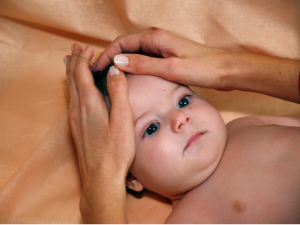
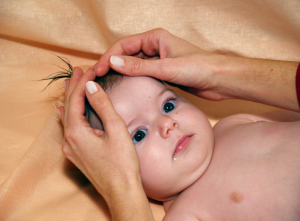
- Nose, Cheeks
Place one thumb on each side of the nose. Start from the nose and gently move your thumbs across the cheeks. Use this massage if the child is suffering from a congested nose. This helps drain the nose and release the respiratory tract.
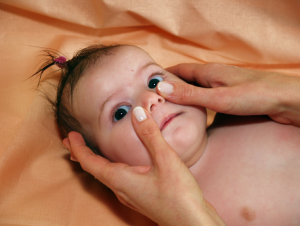
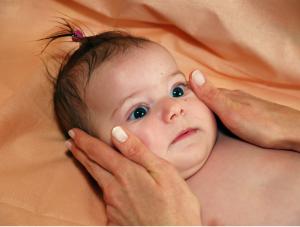
- Chin
Place the thumbs in the middle of the chin. Starting from the middle, move your thumbs gently across the chin.
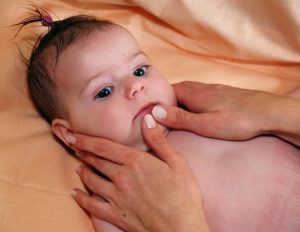
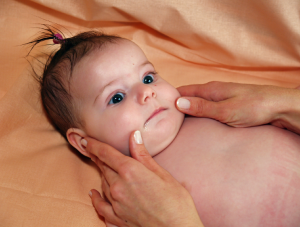
II. ARM MASSAGE
- Shoulders
Place both hands on the infant’s shoulders. Gently move your hands across the shoulders, upper arms and finally the lower arms. Try to cover as much of the arms as possible with your palms.
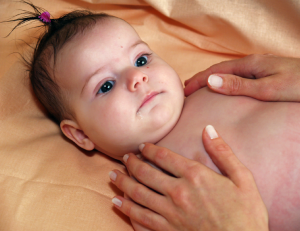
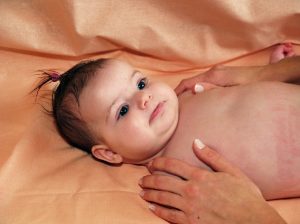
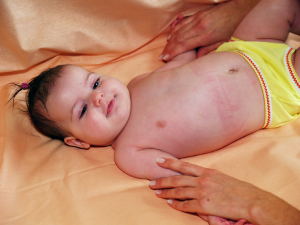

- Upper arm
Massage only one arm. Use both hands to hold the child’s upper arm. Slowly move downwards, across the lower arm and fist. Use your entire palm to cover the arm, as if you were gently pulling something. Do not use your fingertips, because this is not pleasant for the child. Repeat several times on one arm, then switch to the other arm.
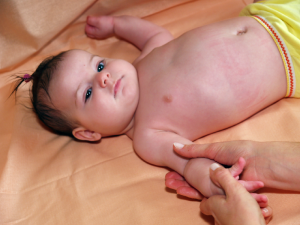
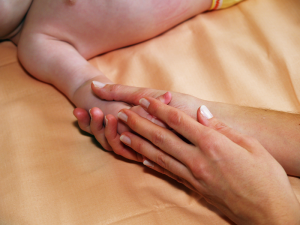
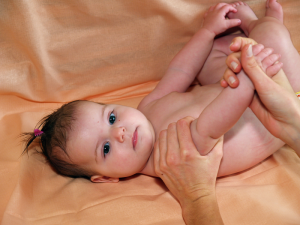
- Forearm
Massage one arm. Use one hand to hold the child’s arm in your fist. Close the other hand around the child’s so that it forms a ring. Begin massaging in the upper part of the arm and move downward until you reach the baby’s hand. Repeat several times on one arm, then switch to the other arm.

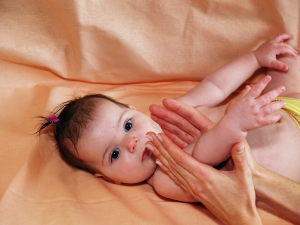
- Fist and fingers – part 1
Massage one arm. Bring your fingers together and place your hands on the sides of the child’s upper arm. Roll your hands across the upper arm, then the lower arm and finally the hand. Repeat several times on one arm, then switch to the other arm.
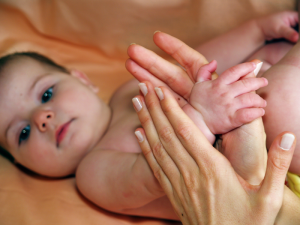
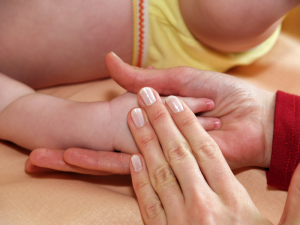
- Fist and fingers – part 2
If the child’s fists are closed, place your palm below the child’s palm. Gently caress the upper part of the fist with the fingers of the other hand. The movement begins on the fingers and continues toward the wrist. After several repetitions of this movement, the child will open the fist, establishing palm-to-palm contact.
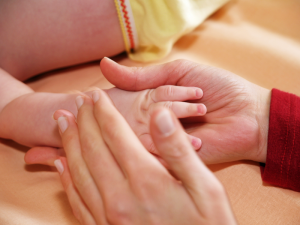
III. CHEST MASSAGE
- Chest
Place both hands in the middle of the chest. Make gentle stroking movements towards the shoulders, then the sides of the chest and finally end in the middle of the chest. The massage consists of continuous movements: one circle commences as soon as the other one ends. Make 6 – 7 circles in a row.
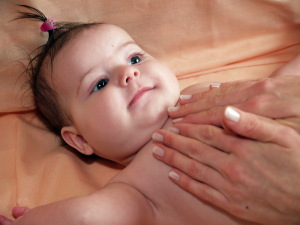
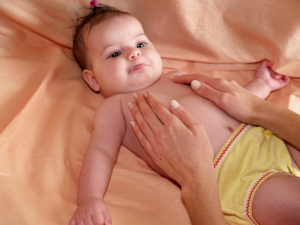
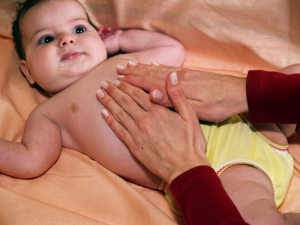
IV. STOMACH MASSAGE
- Stomach part 1
Place one hand on the bellybutton (if you are right-handed, this should be the left hand). Use the right hand to exert gentle pressure and move your hand clockwise (left to right). When your hands meet each other, raise the right hand from the stomach and continue with a new cycle of movements. The hand placed on the bellybutton should not move. This is the recommended direction for the massage, because it follows the direction of our digestive tracts.
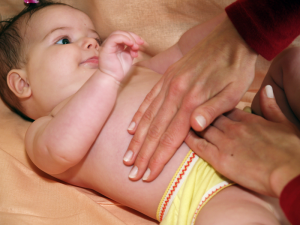
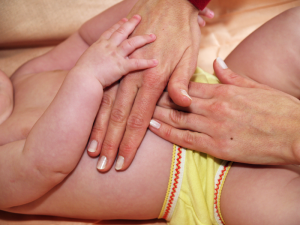
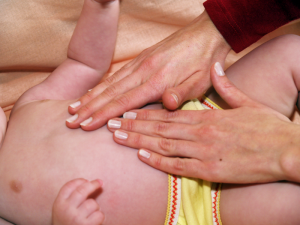
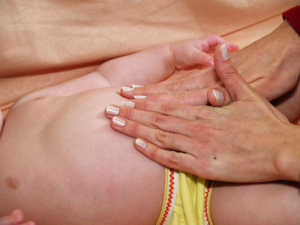
- Stomach part 2
Massage the stomach by bringing the fingers together and moving your palms across the stomach. Move from the upper part of the stomach towards the lower. When one palm reaches the lower part of the stomach, the other should start moving from the upper part. The hands take turns moving across the stomach. Make 6–7 hand changes in one massage cycle.
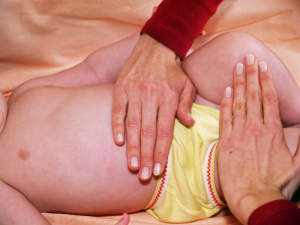
V. LEG MASSAGE
- Thigh
Place both hands on the infant’s hips and upper legs. Move them gently across the knees, down the lower leg, until you reach the feet. Use your palms to cover as much of the legs as possible.
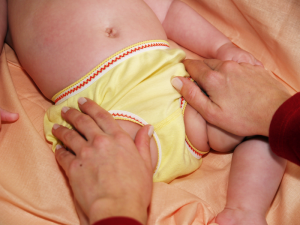
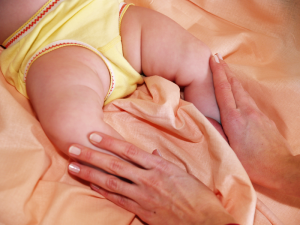
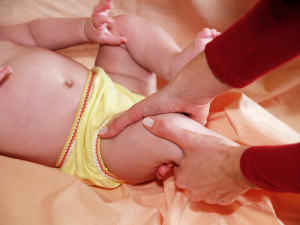
- Lower leg – part 1
Massage one leg at a time. Use both hands to hold the leg around the thigh. Use your entire palm to cover the leg. Move your hand down the upper leg towards the foot, as if you were gently pulling something. Be careful not to not use your fingertips, because this is not pleasant for the child. Repeat several times on one leg, then switch to the other leg.
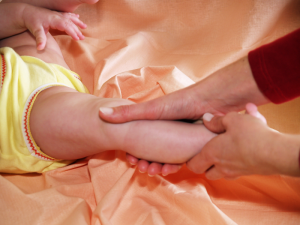
- Ankles
Massage one leg at a time. Use one hand to hold the child’s ankle with one hand. Close the other hand around the leg and then move it down the upper leg all the way to the ankle.
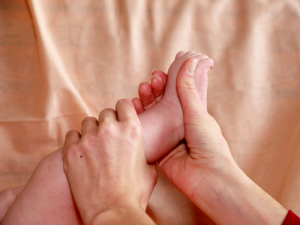
- Lower leg – part 2
Massage one leg. Bring your fingers together and place them on each side of the child’s leg. Roll your hands across the legs, from the upper leg towards the foot. Repeat several times on one leg, then switch to the other leg.
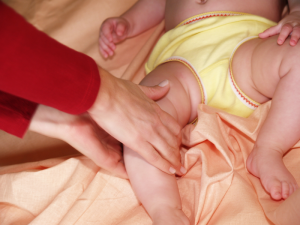
- Feet – part 1
Place your thumbs in the middle of the sole. The thumbs are facing upward. Gently move them across the sole, from the middle towards the outer edges. Make sure the thumbs stick closely to the foot. The sole is full of nerve endings, so each touch stimulates a large number of nerve cells. It is therefore good to include the feet in the massage so the infant may be exposed to as many stimuli as possible. Massage one foot several times, then switch to the other foot.
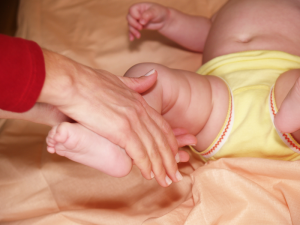
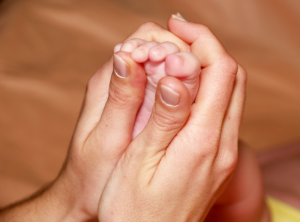
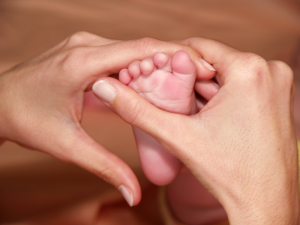
- Feet – part 2
The soles can also be massaged horizontally. Place the thumb horizontally on the lower part of the sole. Massage by moving the thumb from the upper to the lower part of the sole. When you reach the bottom of the sole, start again at the top with the other thumb. Use both thumbs interchangeably. Repeat several times on one foot, then switch to the other foot. Pay attention to the area below the toes. Make sure you massage it. This will stimulate circulation in the feet.
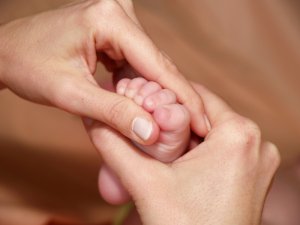
- Feet – part 3
You can also use the entire palm to perform the massage. Use one hand to hold the lower leg for stability. Place your palm on the sole and exert gentle pressure. Separate the palm from the sole and repeat several times.
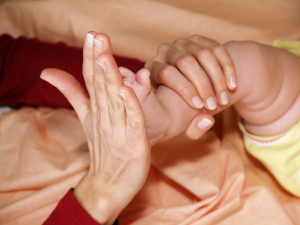
VI. BACK MASSAGE
- Upper, middle and lower back massage with child lying on his/her stomach
The infant should be lying on his/her stomach. The massage consists of three parts: first, massage the upper, then the middle and finally the lower part of the back and the behind. Place your hands on the middle of the infant’s back and move them gently towards the outer edges.Repeat several times on one part of the back, then switch to a different part.
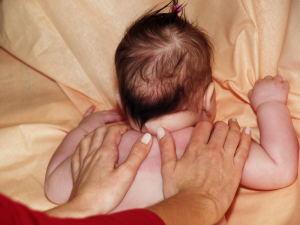
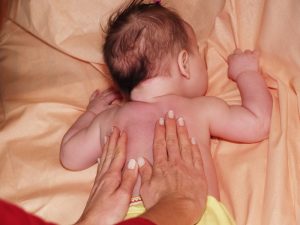
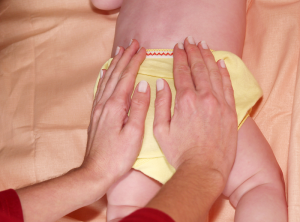
- Upper, middle and lower back massage with child lying on his/her stomach in mothers lap part 1
Back massage can also be performed while the infant is lying on the stomach in the mother’s lap. Place one hand on the behind, and use the other to make horizontal smoothing movements. Begin with the shoulders and end with the behind where the hands meet. It should be noted that the hand should adapt to the infant’s back, so that it sticks to it as closely as possible.
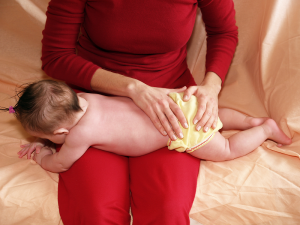
- Upper, middle and lower back massage with child lying on his/her stomach in mothers lap part 2
The child assumes the same position as in the previous massage. Place one hand on the soles of the child’s feet, and use the other one to make horizontal movements across the back. Begin with the shoulders and end with the behind. Let your hand adapt to the back, so that it sticks to it as closely as possible.
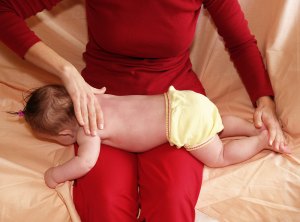
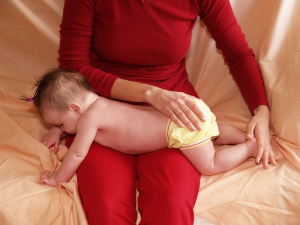
- Upper, middle and lower back massage with child lying on his/her stomach
If you are following the order presented here, we suggest that you end with the following exercise: while the child is lying on the stomach, move your hand from the upper part of the back towards the lower. When the palm of one hand reaches the bottom part of the back, use the other hand to start from the top. The hands move interchangeably.
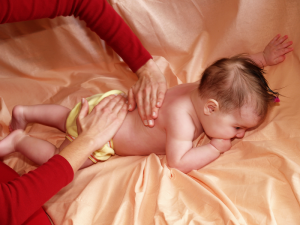
References:
- Arora J, Kumar A, Ramji S. Effect of oil massage on growth and neurobehavior in very low birth weight preterm neonates. Indian Pediatr; 2005, 42(11):1092-100.
- Cullen-Powell LA, Barlow JH, Cushway D. Exploring a massage intervention for parents and their children with autism: the implications for bonding and attachment. J Child health Care; 2005, 9(4):245-55.
- Beal JA. Evidence for best practices in the neonatal period. MCN Am J Matern Child Nurs; 2005, 30(6):397-403; quiz 404-5.
- Dennis CL. Treatment of postpartum depression, part 2: a critical review of nonbiological interventions. 2004, J Clin Psychiatry, 65(9):1252-65.
- Bond C. Baby massage: a dialogue of touch. J Fam Health Care; 2002, 12(2):44-7.
- Diego MA, Field T Hernandez-Reif M. Vagal activity, gastric motility, and weight gain in massaged preterm neonates. J Pediatr; 2005, 147(1):50-5.
- Field T. et al. Targeting adolescent mothers with depressive symptoms for early intervention. Adolescence; 2000, 35(138):381-414.
- Field T, Grizzle N., Scafidi F, Abrams S & Richardson S. Massage therapy for infants of depressed mothers. Infant Behavior and Development; 1996, 19:109-114.
- Field, T., Schanberger, S., Scafidi, F., Bauer, C., Vega-Lahr, N., Garcia, R., Nystrom, J., and Kuhn, C. Taktile-kinesthetic stimulation effects on preterm neonates. Pediatrics; 1986, 77:654-658.
- Karl, DJ. The interactive newborn bath. MCN Am J Matern Child Nurs; 1999, 24(6):280-6.
- Lee, HK. The effect of infant massage on weight gain, physiological and behavioral responses in premature infants. Taehan Kanho Hakhoe Chi; 2005, 35(8):1451-60
- Lowinger, S. Dimitrosky, L. Strauss H. and Mogilner, C. Maternal social and physical contact: links to early infant attachment behaviors. Journal of Genetic Psychology; 1995, Dec., Vol. 156, 461-477.
- Mainous RO. Infant massage as a component of developmental care: past, present, and future, Holist Nurs Pract; 2002, 16(5):1-7.
- NICHD Early Child Care Research Network. The effects of infant child care on infant-mother attachment security: Results of the NICHD Study of Early Child Care. Child Development; 1997, 68 (5), 860-879.



